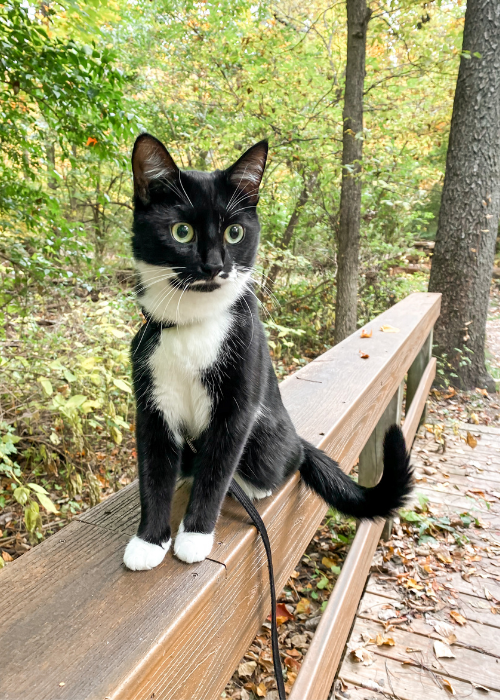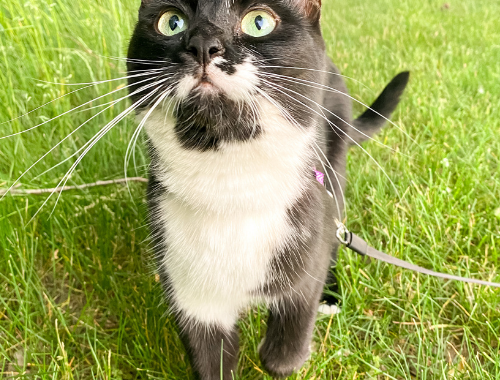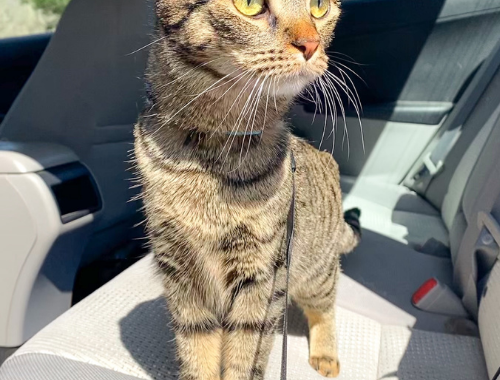
What To Train Your Cat To Make Things Easier In The Future
“My cat would never let me do that”. It is a common thing people say when their cat does not tolerate something. But often times, it is because their cat was never trained to tolerate it. Or maybe was trained the wrong way, making it a negative experience. Cats are completely trainable, and more and more people are starting to realize this! So, what are some things you can train your cat to do to make things easier for the future? From harness training to nail trims, here are our top essentials to train your cat.
But First… Clicker Training!
Before you train your cat, you need to understand how to train them. Unfortunately, there is no one size fits all for this. All cats are individuals and respond to things differently. The key is to find an effective way for you and your cat to communicate together. Find out what works best for your cat, and work with them that way. One thing that many cat owners have great success with is clicker training. You can check out our post on How To Clicker Train here. It is a form of positive reinforcement, rewarding good behaviors you want your cat to do. Cats have shown to respond very well to this form of training, so we highly recommend you check it out! It can actually be used for many of the things on our list below.
What Should You Train Your Cat To Do?
Harness Training
There are so many benefits to harness training your cat. Taking them for walks gives them physical exercise and mental stimulation. It also helps strengthens your bond together and forms trust. But on top of this, it helps build confidence and awareness in new situations. This can help them feel safer when they are in an unfamiliar area. Harness trained cats often have much more confident personalities and handle change better. Of course, it is not true for every leashed trained cat, but it is for many. This can come in handy when traveling if you ever bring your cat along.
We have many posts on this topic, including How To Harness Train and the Best Harnesses.
Carrier Training
The carrier should be a safe place for your cat. If you practice with them and teach them to love it, transporting them in much easier. Whether you are taking them to the vet, on a car ride, or wherever, if they feel safe in the carrier, they will go in there. Many people often only use the carrier for vet trips. This causes the cat to associate the carrier with getting shots or stressful situations. If the carrier also comes with good times, they can learn to love it and will not fight you when they have to go in there.
We have posts on How To Backpack Train and the Best Backpacks.
Teaching Tricks
While tricks may seem like something to teach for fun, they are also very useful. Teaching your cat to sit or stay can help prevent door dashing. Having them know their name and come when you call is also great in case they do ever get outside by accident. When taking them outside on leash, you can call them to come to get them to walk in the right direction. Another trick that is helpful outside is to have them jump up onto the backpack.
There are also many fun tricks you can teach your cat. Working on tricks is a great way to give your cat mental stimulation. It also can help strengthen your bond and build trust. Teaching tricks is a good way to learn to communicate with each other too. Cat School has a great course, and there are great videos on YouTube too.
Handling/Nail Trims
Holding your cat and getting them used to being touched is very beneficial. If they are used to being handled often, they will be less nervous being held at the vet’s office. Touching their ears, feet, belly, and more are great ways to get them used to this. It helps them know that every time you touch them in that area, something bad does not always happen. This can help alleviate a lot of stress that comes with veterinary visits.
Touching their paws and gently pushing to reveal their claws is also a great way to get them used to nail trims. Once they get comfortable with you doing that, you can start trying to clip them. You want to get a proper nail clipper that you feel comfortable using. Also, when you clip, only clip the tips of the nail off. If you can only do a couple of toes before your cat gets fussy, that is okay. You can clip them all over a few days if needed.
Note: this is NOT the same as declawing. Declawing a cat is a painful procedure that involves amputating the last bone in each toe off. It is the equivalent to amputating a person’s finger off at the last knuckle. This procedure is illegal in many places, and we never recommend this. There are many alternatives to help your cat stop scratching.
Car Rides
Car rides are a common thing that causes stress in cats. Many times, its because your cat only goes in the car when it goes to the vet, which is stressful for them. So getting them used to the car and taking them for rides or other places that do not end with a vet trip, can help alleviate this stress. Another reason may be motion sickness. If this is the case, work on helping your cat work through this. There are many ways to help, and if all else fails, motion sickness medication for the vet can help. All cats respond differently. For example, some cats do best when they cannot see out of the window, whereas others need to see out. So it is a little bit of trial and error to see what works best for your cat.
We have posts on Stress Free Car Rides and battling Motion Sickness to help give you some ideas and tips.
Getting Used To Water
Cats are naturally clean animals. They spend a lot of time grooming themselves, and therefore do not regularly need baths. In fact, regular bathing can cause skin dryness and irritation. However, there comes times where your cat may have gotten into something and really needs that bath. When that time comes, it will be much easier if they are calm near water.
Getting them used to water is a great idea if you will be taking them swimming or boating too. We have a post on How To Kayak With Your Cat if you want to read that.
Socialize – people and other pets
Socialization is key when you train your cat. It introduces them to new situations and helps set them up with more confidence. The prime age for socialization is around 2-8 weeks of age. But often times, unless you are raising the kitten yourself, you will not have your cat at this age. This does not mean you should not still work on this when you get them though. Kittens are generally more susceptible to strangers or new things since they do not know much else, but older cats can be trickier. Try having people over to visit so your cat gets used to strangers. And if they have pets that are friendly, try introducing them to your cat too. Always read your cats body language, and if they get too stressed or overwhelmed, separate them and let them be for a little. You do not want to scare them or make it a bad experience.
Sleep Schedule
Has your cat ever woken you up in the middle of the night? Cats are considered nocturnal animals and become more active in the evenings. But you can help adjust their sleep schedule to yours. The best way to do this is to keep them mentally stimulated or physically active before bedtime. You can play with them, take them outside for a walk, give them a food puzzle, or whatever else helps keep them entertained. You want to keep them awake for the last hour or two before you go to bed, so that they get tired.
Another trick is to feed them before bed. If you play with them for a set time, then feed them, they will eat, groom themselves a bit, and lay down for a nap. This is a great bedtime routine to implement to help your cat stay on your schedule.
Conclusion:
There is no doubt that cats are in fact trainable. The barrier is communication. Cats cannot understand what we are asking them to do. They do not understand when you yell at them. Once you and your cat find the best way to communicate between the two of you, it will be much easier to train your cat. And training your cat to be comfortable with the things on this list can help make things much easier in the future, for you and your cat. Hopefully, training some of these things early can help alleviate some stress your cat may feel. Good luck!

Meet Youkie
You May Also Like

HOW TO FIND THE RIGHT BACKPACK FOR YOU AND YOUR CAT
June 12, 2020
Best Tips For Building Trust With Your Cat
June 18, 2021

